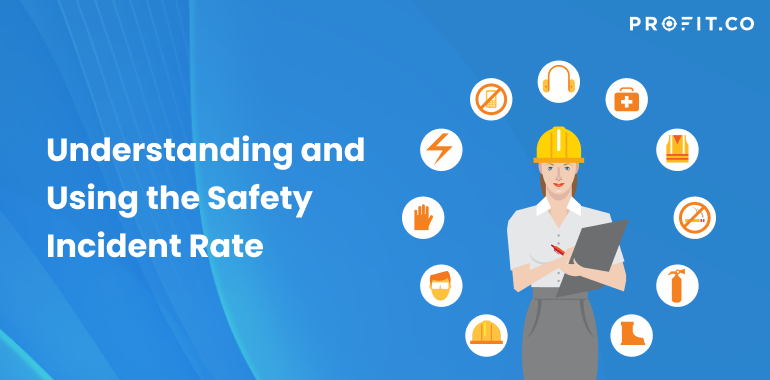In the relentless pursuit of a safe and healthy work environment, organizations strive to identify and mitigate potential hazards. Here, the Safety Incident Rate (SIR) emerges as a crucial metric, offering valuable insights into a workplace’s safety performance. This blog explores SIR, delving into its definition, significance, calculation methods, and practical applications.
What is the Safety Incident Rate (SIR)?
The SIR is a quantitative measure that reflects the frequency of work-related injuries and illnesses within a specific timeframe, typically a year. It reveals how often safety incidents occur relative to the total employee work hours. By expressing this as a rate (usually per 100 employee work hours), SIR allows for standardized comparisons across companies and industries, regardless of their workforce size.
Why is the Safety Incident Rate Important?
The SIR serves as a vital indicator of an organization’s safety culture and the effectiveness of its safety programs.
Here’s a breakdown of its importance:
Benchmarking Safety Performance
SIR enables organizations to compare their safety record against industry averages or their own historical data. This helps companies to compare and identify areas for improvement and track progress over time.
Prioritizing Safety Initiatives
A high SIR highlights a critical need to invest in safety programs and interventions. Analyzing the types of incidents can reveal specific areas where these resources should be directed.
Enhanced Accountability
Tracking SIR fosters accountability across all organizational levels. It motivates leadership to prioritize safety measures and inspires employees to actively participate in creating a safe work environment.
Communication and Transparency
Utilizing SIR as a key performance indicator (KPI) promotes open communication about safety. Sharing trends with employees fosters awareness and encourages their involvement in safety initiatives.
“We are stubborn on vision. We are flexible on details”
Calculating the Safety Incident Rate
The calculation of SIR follows a straightforward formula:
SIR = (Number of Recordable Cases x 200,000) / Employee Work Hours
Here’s a breakdown of the formula components:
- Number of Recordable Cases: This refers to the total number of work-related injuries and illnesses that meet the reporting criteria set by a regulatory body like the US Occupational Safety and Health Administration (OSHA).
- 200,000: This is a constant value used to standardize the rate per 100 employee work hours.
- Employee Work Hours: This represents the total number of hours all employees work during a specific period (e.g., month, year).
Ready to start your KPI journey today?
Setting Measurable Goals for Safety: The Power of OKRs
While the SIR provides a valuable snapshot of safety performance, it’s crucial to translate insights into actionable goals. Here’s where Objectives and Key Results (OKRs) come into play. OKRs offer a powerful framework for setting clear, measurable safety objectives and aligning them with specific, time-bound results. By establishing a hierarchy of objectives and key results that cascade down through the organization, everyone can be held accountable for achieving a safer workplace.
Example: Setting an OKR with SIR
Objective: Reduce workplace safety incidents
KR 1: Achieve a Safety Incident Rate (SIR) below 2.0 by year-end.
Initiatives
- Conduct a comprehensive safety training program for all employees.
- Regularly conduct audits to identify and address potential hazards.
- Encourage employee participation in incident reporting and safety improvement suggestions.
KR 2: Increase employee safety awareness from 30% to 60%
Initiatives
- Launch ongoing safety awareness campaigns and communication initiatives.
- Reward employees who consistently demonstrate safe work practices.
- Integrate safety discussions into regular team meetings and performance reviews.
KR 3: Reduce the number of lost workdays due to injuries from 5% to 2%
Initiatives
- Implement a robust return-to-work program to facilitate reintegration of injured employees.
- Invest in ergonomic assessments and workplace modifications.
- Partner with healthcare providers to ensure timely medical attention.
Best Practices for Utilizing SIR
- Track SIR over Time: Monitor SIR trends to identify patterns and measure the effectiveness of safety initiatives.
- Segment SIR Data: Analyze SIR by department, job type, or incident type to pinpoint areas with higher risks.
- Invest in Prevention: Prioritize preventative measures like training, hazard identification, and risk mitigation strategies.
- Employee Engagement: Actively involve employees in safety discussions, reporting, and improvement efforts.
- Continuous Improvement: Regularly review and update safety programs based on data insights and evolving needs.
Conclusion
The Safety Incident Rate provides a valuable lens for organizations to assess and improve their safety performance. By actively monitoring SIR, implementing targeted initiatives, organizations can create a safety and a more productive work environment for all employees.
Ready to start your OKR journey for FREE?
Related Articles
-
From Baseline to Target: Mastering the Science of KPI Progress
KPIs (Key Performance Indicators) are more than just numbers on a spreadsheet they're the compass that guides your business toward... Read more
-
Understanding Planned Value and Its Importance in Project Management
In project management, monitoring and measuring progress are essential to ensuring that projects stay on track and deliver expected results.... Read more
-
How to Calculate Billable Utilization and Why It Matters for Your Business
Introduction In the professional services world, tracking how much time your employees spend on billable projects is crucial. Billable utilization... Read more
-
What Is Budget Variance? A Simple Guide to Understanding and Managing It
Introduction Have you ever set a budget for something, only to find out later that you spent way more or... Read more

